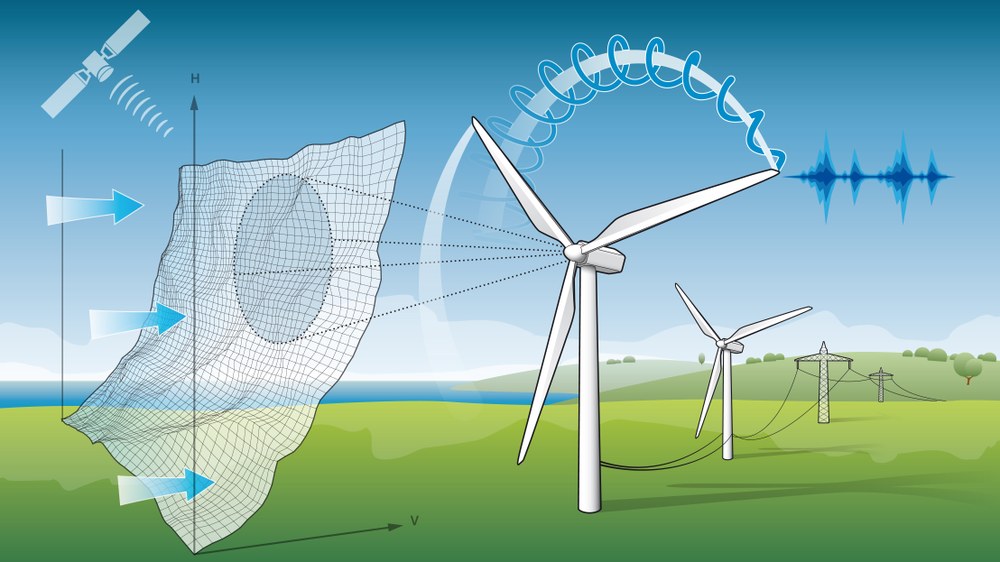Wind energy

'From wind to torque with the Smart Rotor' describes the focus of DLR’s wind energy research. This uses expertise derived from DLR’s extensive aeronautics research work to develop more powerful, quieter and simpler wind turbines.
In a helicopter, lift is generated by the air flowing over the rotor blades. This process is understood in detail at DLR. The physical laws for this also apply in reverse when an incoming air flow drives a wind turbine to efficiently generate electricity. Whether on land or offshore, wind turbines are among the most important technologies for the sustainable supply of energy in Germany and around the world. For the further expansion of sustainable wind energy, a significant increase in the performance of wind turbines and wind farms is required. At the same time, the wind turbines must become quieter than before, and the costs of production and maintenance should also be reduced.
The DLR institutes of Aeroelasticity, Aerodynamics and Flow Technology, Lightweight Systems, Flight Systems, Atmospheric Physics and Networked Energy Systems, together with the DLR Wind Energy Experiments Facility are the organisations primarily involved in this work.
Rotor design – aerodynamics, aeroelasticity, structure, production
Experts assume that individual wind turbines will have a power output of up to 20 megawatts in the future. If turbine manufacturers were to enlarge a wind turbine using current designs to this extent, a single rotor blade would be more than 100 metres long and far too heavy at well over 100 tonnes. Conventional rotor blades are also not sufficiently rigid for this; it would not be possible to safely maintain the required minimum distance between the blades and the tower. For the performance classes targeted today, aerofoils, structures, construction methods and materials used must be adapted to the new requirements.
The DLR institutes are developing rotor blades with a high proportion of carbon-fibre reinforced composites, which are five times stronger and stiffer than the standard material that is reinforced with glass fibre. The effects of wind loads on the structure and materials are being studied by the aeroelasticity research department. Structurally lightweight designs can provide greater stability for the rotor blades. At the same time, automated production processes can reduce manufacturing costs.
Smart rotor blades
With an intelligent structure, sensor technologies and controls, rotor blades would not need to be restricted even in the case of strong gusts of wind. At DLR, we are contributing to this field by developing what are referred to as smart blades – for example rotor blades that can dynamically change their configuration. The DLR institutes are working both with numerical simulations and in wind tunnels that are unique in Europe. The necessary test infrastructure is jointly provided with partners in the Research Alliance Wind Energy so that every important aspect of wind turbines can be investigated.
Aeroacoustics and sound generation
The expansion of onshore wind energy is increasingly leading to questions of public acceptance, for example concerning noise levels. DLR is therefore not only researching the computation of sound fields produced by wind turbines and their propagation, but also the design of high-performance and at the same time low-noise rotor blades as well as noise reduction measures.
Wind energy potential and wind field characterisation
Expertise for wind energy research at DLR also comes from the fields of atmospheric research and remote sensing. Using satellite data and ground-based systems, the DLR institutes are working on even more accurate predictions for wind speeds at the sites of individual turbines and wind farms. These forecasts help wind turbine and grid operators to optimally control their installations and accurately predict the power fed into the grid. Using optical sensor systems, referred to as lidar systems, the wind flows and their interactions can be recorded within entire wind farms. This is also a prerequisite for a better understanding of the aero-acoustic behaviour and contributes to an improvement in noise abatement for the local population. With long time series of wind speeds, investors can better assess different locations for wind turbines.
Wind energy research at full scale – the new Research Wind Farm in Krummendeich
In future, DLR will operate a research wind farm in Krummendeich, in the Stade district of Lower Saxony. In this unique research infrastructure, more than 3000 sensors on wind turbines and measurement masts will continuously supply data to investigate the loads and noise generated during operation. In 2023, the research wind farm is scheduled to start trial operations and also the first feed-in of electricity. In Krummendeich, full-scale wind energy research will be possible in order to develop new technologies and increase the acceptance, efficiency and economic viability of wind energy.
